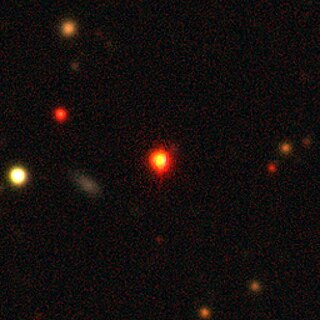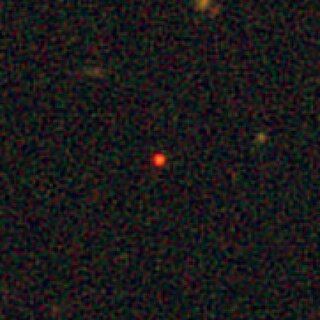
In astronomy, stellar classification is the classification of stars based on their spectral characteristics. Electromagnetic radiation from the star is analyzed by splitting it with a prism or diffraction grating into a spectrum exhibiting the rainbow of colors interspersed with spectral lines. Each line indicates a particular chemical element or molecule, with the line strength indicating the abundance of that element. The strengths of the different spectral lines vary mainly due to the temperature of the photosphere, although in some cases there are true abundance differences. The spectral class of a star is a short code primarily summarizing the ionization state, giving an objective measure of the photosphere's temperature.

Brown dwarfs are substellar objects that have more mass than the biggest gas giant planets, but less than the least massive main-sequence stars. Their mass is approximately 13 to 80 times that of Jupiter (MJ)—not big enough to sustain nuclear fusion of ordinary hydrogen (1H) into helium in their cores, but massive enough to emit some light and heat from the fusion of deuterium (2H). The most massive ones can fuse lithium (7Li).

Teegarden's Star is an M-type red dwarf star in the constellation Aries, 12.5 light-years from the Solar System. Although it is near Earth it is a dim magnitude 15 and can only be seen through large telescopes. This star was found to have a very large proper motion of about 5 arcseconds per year. Only seven stars with such large proper motions are currently known. Teegarden's Star hosts a planetary system with at least three planets.
Daniel Apai is a professor and astrophysicist at The University of Arizona in Tucson, Arizona. He is known for his studies of astrobiology, extrasolar planets, and the formation of planetary systems. He is the principal investigator of the Earths in Other Solar Systems team of NASA's Nexus for Exoplanet System Studies and the Hubble Space Telescope Cloud Atlas Treasury program, and Project EDEN, a large survey for habitable planets in the immediate solar neighborhood. He is leading the Nautilus Space Observatory space telescope concept and co-leading the technology development underpinning it.
An object with the spectral type L can be either a low-mass star, a brown dwarf or a young free-floating planetary-mass object. If a young exoplanet or planetary-mass companion is detected via direct imaging, it can also have an L spectral type, such as Kappa Andromedae b.

S Ori 70 or S Ori J053810.1-023626 is a mid-T type astronomical object in the foreground of the σ Orionis cluster, which is approximately 1,150 light-years from Earth. It was discovered on November 24, 2002 by M. R. Zapatero-Osorio and E. L. Martin's team at the Roque de los Muchachos Observatory. It has yet to be determined if it is a field brown dwarf or a 3-million-year-old planet that is part of a cluster. Near-infrared spectroscopy images taken three years after its discovery led to the first motion measurements for the object. Its behavior is significantly different from what may be expected; it was further described as either a low-gravity atmosphere or an atmosphere with metallicity. The object's small proper motion suggests that it is further away than expected if it were a single field T dwarf.
G 196-3 is a young low-mass M dwarf type star which is about 100 million years old. The star is located within the Ursa Major constellation about 71.1 light years away from the Earth. During observations by Instituto de Astrofísica de Canarias in Tenerife, Spain in 1998, a substellar-mass object was discovered to orbit approximately 300 astronomical units (AU) from the star. It was detected using direct imaging.

SZ Crateris is a binary star system in the southern constellation Crater. Both components belong to the main sequence: the primary star has a spectral classification of K5V while the secondary is a red dwarf of spectral class M0V. The radius of the primary is about 66% the radius of the Sun, while the secondary member is only about 42% of the solar radius. In 1994, the two stars were separated by 5.1 arc seconds, which is equivalent to 112.41 astronomical units.
DENIS J081730.0−615520 is a T-type brown dwarf 17 light-years away in the constellation Carina. It was discovered by Etienne Artigau and his colleagues in April 2010. The brown dwarf belongs to the T6 spectral class, with a photosphere temperature of about 1000 K. It has a mass of about 15 MJ or about 1.5% the mass of the Sun.

2MASS J09373487+2931409, or 2MASSI J0937347+293142 is a brown dwarf of spectral class T6, located in the constellation Leo about 19.96 light-years from Earth.

2MASS J00361617+1821104 is a brown dwarf, located in 28.6 light-years from Earth in the constellation Pisces. It was discovered in 2000 by I. Neill Reid et al. Kinematically, it does not belong to any known moving group, been grouped with other "field stars".

Eta Coronae Borealis is a stellar system that lies approximately 58 light-years away. The primary component is a mid-wide binary, while a brown dwarf component is located at a wide separation.

GD 165 is a binary white dwarf and brown dwarf system located in the Boötes constellation, roughly 109 light-years from Earth. Neither of the stars have any known exoplanets.

2MASS J03552337+1133437 is a nearby brown dwarf of spectral type L5γ, located in constellation Taurus at approximately 29.8 light-years from Earth.

PSO J318.5−22 is an extrasolar object of planetary mass that does not orbit a parent star, it is an analog to directly imaged young gas giants. There is no consensus yet among astronomers whether the object should be referred to as a sub-brown dwarf, as a rogue planet or as a young brown dwarf. It is approximately 80 light-years away and belongs to the Beta Pictoris moving group. The object was discovered in 2013 in images taken by the Pan-STARRS PS1 wide-field telescope. PSO J318.5-22's age is inferred to be 23 million years, the same age as the Beta Pictoris moving group. Based on its calculated temperature and age, it is classified under the brown dwarf spectral type L7.
2MASS J0523−1403 is a very-low-mass red dwarf about 40 light-years from Earth in the southern constellation of Lepus, with a very faint visual magnitude of 21.05 and a low effective temperature of 2074 K. It is visible primarily in large telescopes sensitive to infrared light. 2MASS J0523−1403 was first observed as part of the Two Micron All-Sky Survey (2MASS).
2MASS J21265040−8140293, also known as 2MASS J2126−8140, is an exoplanet orbiting the red dwarf TYC 9486-927-1, 111.4±0.3 light-years away from Earth. Its estimated mass, age, spectral type (L3), and Teff are similar to the well-studied planet β Pictoris b. With an estimated distance of around 1 trillion kilometres from the host star, this is one of the largest solar systems ever found.

Backyard Worlds: Planet 9 is a NASA-funded citizen science project which is part of the Zooniverse web portal. It aims to discover new brown dwarfs, faint objects that are less massive than stars, some of which might be among the nearest neighbors of the Solar System, and might conceivably detect the hypothesized Planet Nine. The project's principal investigator is Marc Kuchner, an astrophysicist at NASA's Goddard Space Flight Center.

WISE 2150–7520 AB is a binary brown dwarf 78.9 light-years distant from Earth in the southern constellation Octans. The system is a wide binary with a separation of 341 astronomical units. The primary of the system was discovered in 2005 as an infrared object with high proper motion and in 2008 was found to be an ultracool dwarf with a spectral type of L. The secondary, a much cooler T dwarf, was discovered by volunteers of the citizen science project Backyard Worlds: Planet 9, using data from the Wide-field Infrared Survey Explorer (WISE). The system was followed up by the project scientists with Magellan and Spitzer and a scientific paper describing the binary was published in the Astrophysical Journal in 2020.

Königstuhl 1 is a binary consisting out of the red dwarf LEHPM 494 and the M- or L-type star or brown dwarf DENIS-P J0021.0-4244. While similar low-mass wide binary were known in young star-forming regions, Königstuhl1 was the first wide binary detected in the field and was not associated with a star-forming region.













